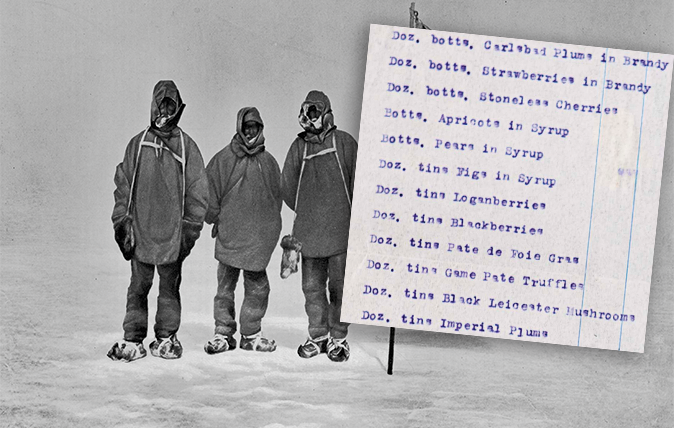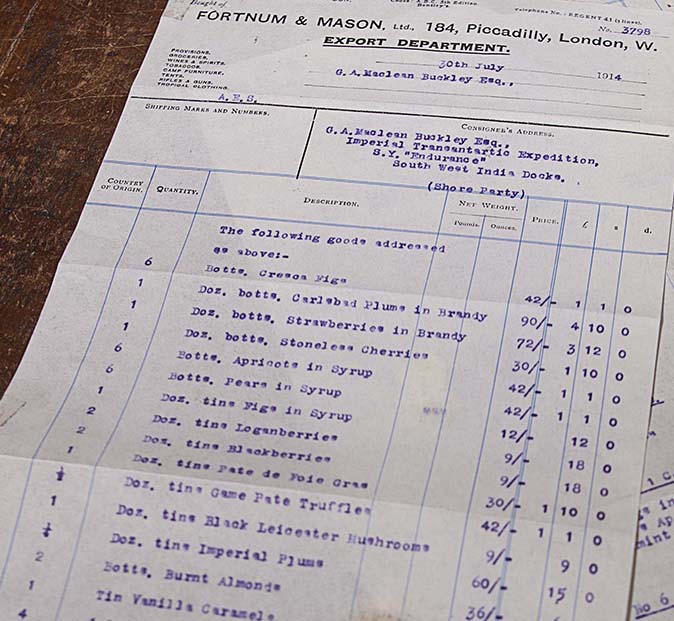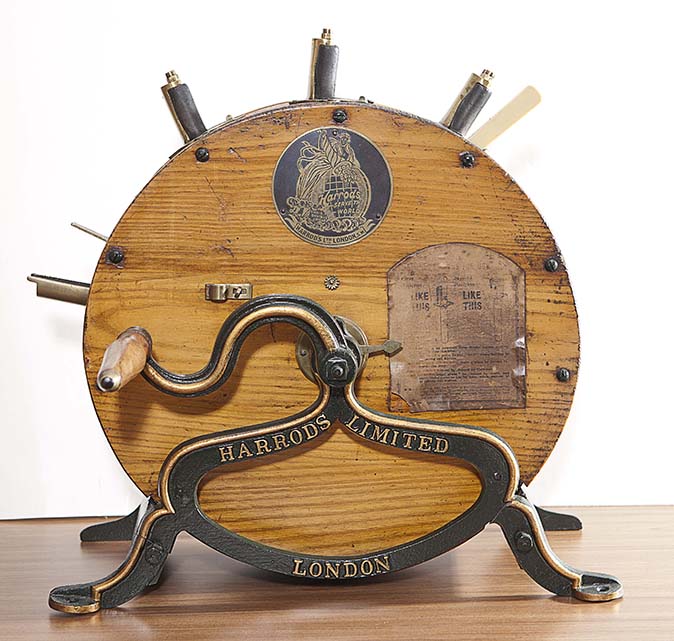Ernest Shackelton’s arctic shopping list, and other secrets of Britain’s great shops
Harrods, Fortnum & Mason and most of Britain's other great retailers have archivists – and they shared some of their finest treasures with Nick Hammond.


‘I don’t normally show people the originals,’ confides Andrea Tanner in the fifth-floor offices of Fortnum & Mason. She hands over a parchment-thin, typewritten inventory from 1914.
It lists a bottle of mint bull’s eyes, a dozen bottles of Carlsbad plums in brandy, game pâté truffles, Black Leicester mushrooms and a tin of vanilla caramels among its contents.
‘It’s from Shackleton’s 1914 transarctic voyage aboard HMS Endurance,’ she says with a smile. ‘It’s one of many special things I’m here to look after.’

Dr Tanner is among a handful of professional archivists working in retail in the UK. She’s a brand guardian, a keeper of the flame, a ruthless haggler and a studier of dusty tomes.
Judy Faraday is another. She’s the head of heritage services for the John Lewis Partnership. ‘I think the best way to describe our job is that everyone has a box of things from their past that they don’t necessarily look at every day, but which they wouldn’t want to throw away,’ she says.
‘I look after a very big box, which holds the corporate memory of the Partnership. Mine is much more than a purely commercial role – it highlights the cultural value of our heritage and charts the constant development of the business.’
The John Lewis Partnership was a revolutionary experiment in commercial democracy from its founder, John Spedan Lewis. He realised his own salary, and that of his father and brother, were roughly equivalent to all the other employee’s salaries combined and spent the rest of his working life redressing the balance.
Sign up for the Country Life Newsletter
Exquisite houses, the beauty of Nature, and how to get the most from your life, straight to your inbox.
‘Without understanding their past, it’s very difficult for our Partners to understand why we do the things we do,’ says Mrs Faraday. ‘How the business has developed and the long-term ethos is important for today and for the future.’

What exactly does a retail archivist do each day? Paper records are now being replaced with digitised ones, so a lot of time is spent organising and dispatching documents to specialists in the field. Archivists are also responsible for storing and protecting valuable works of art that may belong to the company and for buying back long-lost memorabilia. They also lead inductions for new starters, record the memories of former staff members and work alongside current designers and curators to craft modern marketing campaigns. Most of this work goes on backstage, away from the ringing cash tills.
Harrods has two full-time archivists, who have recently moved from the grand store in Knightsbridge to more modern premises in Hammersmith; ‘We had to make way for a new shoe department,’ says archivist Sebastian Wormell with a twinkle in his eye.
However, the move means extra space and Mr Wormell leads me into several rooms of Harrods treasures: catalogues for ordering by the camel, donkey or boatload; bizarrely, a single drum from a complete kit; samples of every Harrods Christmas Bear ever made; and an old-fashioned wooden knife-cleaning machine, made obsolete by the invention of stainless steel.

‘Every one of these items has a story behind it,’ explains Mr Wormell as we stroll through the carefully stored memorabilia. ‘We may end up being the only ones who can tell these stories and that’s why it’s so important we remember them.’
Stories such as the bet between Harry Selfridge and Woodman Burbidge, MD of Harrods, in 1917. Proud of his up-and-coming department store, Selfridge wagered that his company would overtake Harrods’ revenues in a few short years. It didn’t happen. Burbidge’s prize was an utterly remarkable, custom-made rendition of the Harrods building – in solid silver. The model even had a hidden lid that revealed a cigar humidor inside.
It was proudly displayed for many years in the store, on loan from the Burbidge family, but, to Mr Wormell’s dismay, was eventually sold by the Burbidges for £86,000. ‘I’d love to know what happened to it,’ Mr Wormell says, thoughtfully, then brightens. ‘Perhaps one of your readers might know where it is?’

This irrepressible inquisitiveness is key to the archivist’s role and a penchant for detective work and an eye for design are also useful. ‘I’ve been digitising the entire archive for the past 15 years,’ says Anna Buruma, archivist for Liberty on Regent Street. ‘We now have a very rich database, which is on my computer that sits in the middle of the Design Studio. I can show the designers the past as I’m cataloguing the present and they’re inspired by it to produce designs for the future.’
She adds: ‘I’ve had many people coming in to admire our archives, from [Spanish shoe designer] Manolo Blahnik, [English artist] Grayson Perry and [Japanese textile designer] Junya Watanabe.’
As well as Shackleton’s list of goodies, there’s a wealth of other priceless material carefully kept by Dr Tanner at Fortnum’s. One officer’s order book from the Second World War is particularly memorable. It lists tinned lobster and grouse and even Havana cigars available for frontline servicemen with deep pockets.
Of course, the average Tommy had to survive on far less elegant fare; but can you imagine, just for a moment, what must it have felt like to receive a Fortnum & Mason package amid that carnage?

‘The time, the place, how society was in those days, all these things can easily be lost,’ says Dr Tanner. ‘But the fact that companies like ours are still here means we have adapted and changed without forgetting our roots and it’s my job to help keep open that link between the past, present and future.
'Every day is different – you never know what you’re going to end up doing, who you might speak to or what you might discover. It’s endlessly fascinating.’

Country Life is unlike any other magazine: the only glossy weekly on the newsstand and the only magazine that has been guest-edited by HRH The King not once, but twice. It is a celebration of modern rural life and all its diverse joys and pleasures — that was first published in Queen Victoria's Diamond Jubilee year. Our eclectic mixture of witty and informative content — from the most up-to-date property news and commentary and a coveted glimpse inside some of the UK's best houses and gardens, to gardening, the arts and interior design, written by experts in their field — still cannot be found in print or online, anywhere else.
-
 Merlins: Britain's smallest bird of prey is a 'swerving, zigzagging, 240mph weighted missile' that's gutsy enough to chase off a golden eagle
Merlins: Britain's smallest bird of prey is a 'swerving, zigzagging, 240mph weighted missile' that's gutsy enough to chase off a golden eagleSize doesn’t matter when it comes to the fighting spirit of the tiny merlin, a fierce parent and favoured hunting accessory of Mary, Queen of Scots.
-
 The greatest moment in the life of Jessie Owens: Country Life Quiz of the Day, June 13, 2025
The greatest moment in the life of Jessie Owens: Country Life Quiz of the Day, June 13, 2025Breathtaking athleticism and Shakespeare's birthday are among the questions in the final quiz of the week.
